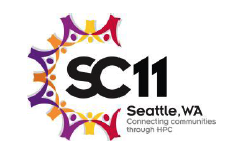* Gordon Bell Finalist
Nov 16 2011
Time: 2:15PM – 3:00PM
Session Chair: Thom H. Dunning, Jr.
Author(s):Leopold Grinberg, Vitali Morozov, Dimitry Fedosov, Joseph Insley, Michael Papka, Kalyan Kumaran, George Karniadakis
Room: TCC LL4/LL5
[.ics]
Interfacing atomistic-based with continuum-based simulation codes is now required in many multiscale physical and biological systems. We present the computational advances that have enabled the first multiscale simulation on 190,740 processors by coupling a high-order (spectral element) Navier-Stokes solver with a stochastic (coarse-grained) Molecular Dynamics solver based on Dissipative Particle Dynamics (DPD). The key contributions are proper interface conditions for overlapped domains, topology-aware communication, SIMDization, multiscale visualization and a new domain partitioning for atomistic solvers. We study blood flow in a patient-specific cerebrovasculature with a brain aneurysm, and analyze the interaction of blood cells with the arterial walls endowed with a glycocalyx causing thrombus formation and eventual aneurysm rupture. The macro-scale dynamics (about 3 billion unknowns) are resolved by Nektar – a spectral element solver; the micro-scale flow and cell dynamics within the aneurysm are resolved by an in-house version of DPD-LAMMPS (for an equivalent of about 100 billions molecules).
